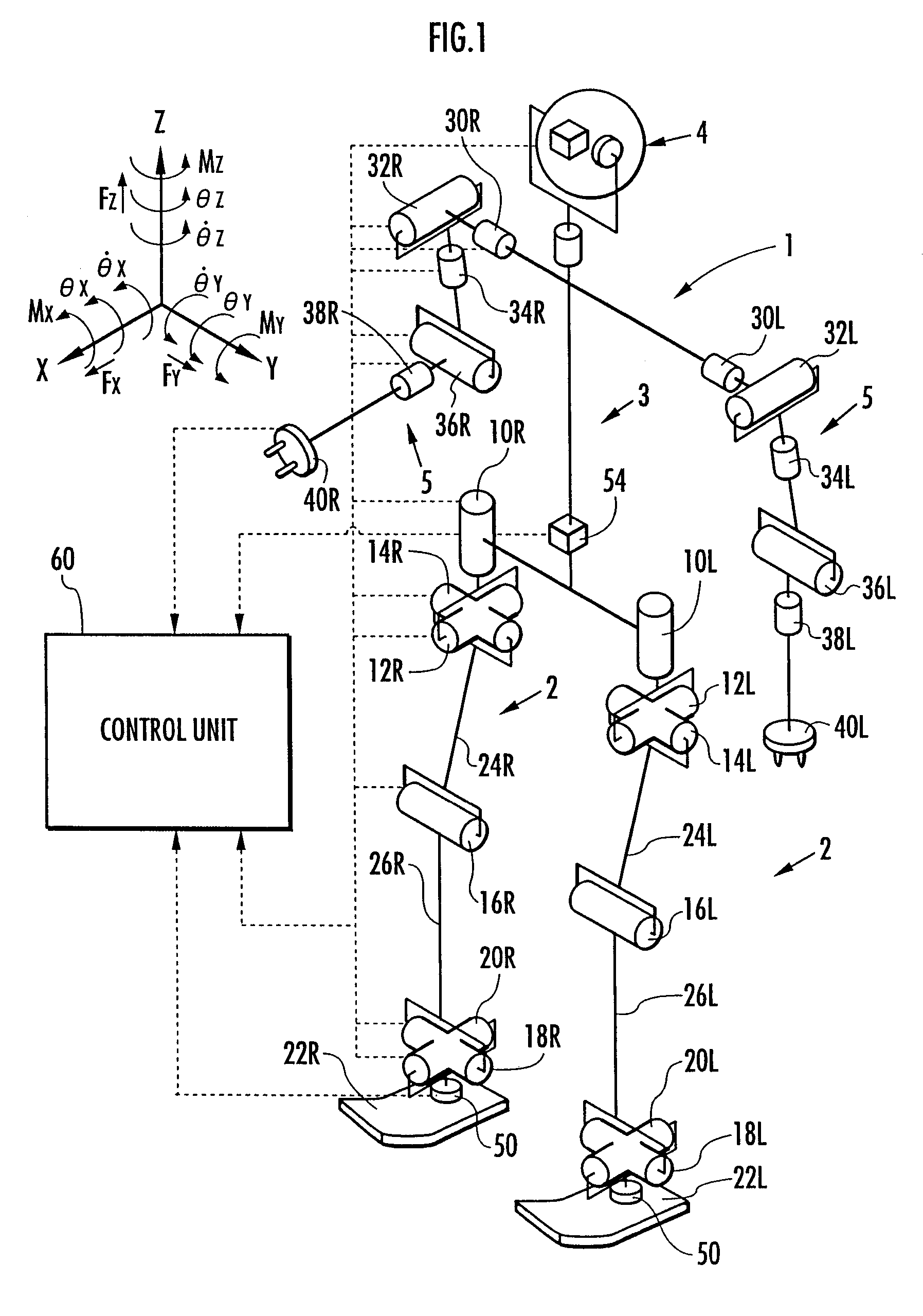Gate generating system for mobile robot
a technology of generating system and robot, which is applied in the direction of programme control, distance measurement, instruments, etc., can solve the problems of low dynamic accuracy of dynamic model with high linearity, prone to errors relative to the actual kinetics of the actual robot, and inability to operate the actual robot in stability, so as to achieve the effect of convenient and efficient search and easy and efficient search
- Summary
- Abstract
- Description
- Claims
- Application Information
AI Technical Summary
Benefits of technology
Problems solved by technology
Method used
Image
Examples
first embodiment
[0121]A body motion mode and dynamic models used for generating gaits in the first embodiment will now be explained.
[0122]In a gait that includes a floating period, such as a running gait, or walking on a low-friction floor surface, there are cases where a dynamic balance condition cannot be satisfied while the floor reaction force horizontal component of a desired gait being within a permissible range (or within friction limits) simply by adjusting a body horizontal acceleration. Hence, in the present embodiment, two motion modes (a body translation mode and a body rotation mode) of the body 3 explained below are compositively generated so as to satisfy the dynamic balance condition while the floor reaction force horizontal component of a desired gait being within a permissible range (or within friction limits).
[0123]As shown in FIG. 6(a), if only a body horizontal acceleration is perturbed from a certain motion state, then the total center-of-gravity horizontal acceleration and th...
second embodiment
[0256]The above is the second embodiment according to the present invention.
[0257]According to the aforesaid first embodiment, in a plurality of dynamic models, the motion / floor reaction force models representing the relationships between their motions and floor reaction forces have been set to have structures that are different from each other. Alternatively, however, a plurality of dynamic models may share the same motion / floor reaction force models (the structures of the mass points, inertias, and the like and dynamic equations (equations of motion) of the models) and have different restrictive conditions related to motions or floor reaction forces of the robot 1 that are added to the individual dynamic models. The following will explain an example thereof as a third embodiment. The motion / floor reaction force models of the plurality of (three in the present embodiment) of dynamic models are set to be the same as the motion / floor reaction force models of, for example, the second ...
third embodiment
[0258]Supplementally, in the n-th dynamic model (n=1, 2 or 3), the permissible range of a floor reaction force horizontal component broadens and the linearity increases as the value of n decreases. Hence, when searching for search objects of a gait parameter (a normal gait parameter or a current time's gait parameter) by the first dynamic model, the search processing can be promptly completed.
[0259]Further, the model having the highest dynamic accuracy among the plurality of dynamic models may be the same as the aforesaid full model. In this case, it is desirable to set the floor reaction force horizontal component permissible ranges for these plurality of dynamic models (the dynamic models used in S024 and S028 of FIG. 12 described above) to be wider than those for full-model correction in order to enhance the convergence of the search processing of a gait parameter.
[0260]Supplementally, it is effective for the plurality of dynamic models used in the aforesaid S024 and S028 of FIG...
PUM
 Login to View More
Login to View More Abstract
Description
Claims
Application Information
 Login to View More
Login to View More - R&D
- Intellectual Property
- Life Sciences
- Materials
- Tech Scout
- Unparalleled Data Quality
- Higher Quality Content
- 60% Fewer Hallucinations
Browse by: Latest US Patents, China's latest patents, Technical Efficacy Thesaurus, Application Domain, Technology Topic, Popular Technical Reports.
© 2025 PatSnap. All rights reserved.Legal|Privacy policy|Modern Slavery Act Transparency Statement|Sitemap|About US| Contact US: help@patsnap.com



